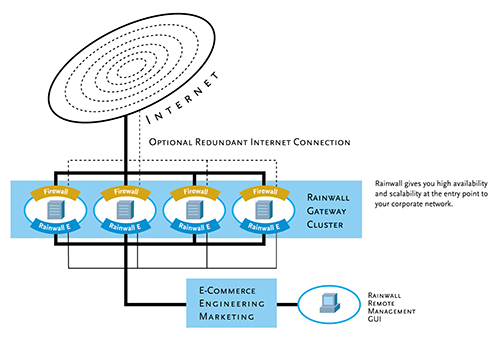Rocket Science for the Internet
As more people move onto the information highway, computer networks must balance the open, free-access of the Internet with security and manageability concerns. A new software product, derived from research conducted at the California Institute of Technology (Caltech) under contract with NASA's Jet Propulsion Laboratory (JPL) and the Defense Advanced Research Projects Agency (DARPA), is the first fully distributed gateway clustering solution for the Internet.
The original research was sparked by DARPA. Wanting to know if reliable systems can be built with off-the-shelf-products, DARPA approached JPL to make use of their world class expertise in designing fault-tolerant systems. Existing testbeds and future applications at JPL made the NASA center the ideal place for DARPA to turn. JPL then contracted Caltech scientists to build a system of interconnecting computers with a redundant system.
After four years of development, Caltech delivered a software program making use of Reliable Array of Independent Nodes (RAIN). It has been in use at JPL's Center for Integrated Space Microsystems (CISM). Center director Leon Alkalai foresees using RAIN on International Space Station missions or the Space Shuttle, where astronauts could string together laptop computers to behave as a single system.
Upon completion of the research, RAIN developers, Caltech professor Shuki Bruck, and four of his colleagues, secured a patent and exclusive licensing agreement from Caltech to make RAIN commercially available. The result is Rainfinity, a software company that released its first product, Rainwall, in April 1999.
RAIN has three components: data storage across nodes and retrieval even if some nodes fail, communications in a redundant network between multiple nodes, and computing that transparently recovers if a node fails. Rainwall utilizes these capabilities to run a cluster of computer workstations, creating a distributed Internet gateway.
When Rainwall detects a failure in software or hardware, traffic is automatically shifted to a healthy gateway without any interruptions in service. This makes Rainwall-powered computers ideal for hosting applications such as firewalls.
Traditional systems using firewalls have typically worked like a gate and heavy traffic or system failure could cause bottlenecks. Rainwall provides load balancing for systems by directing network traffic evenly across several machines, or in cases where one machine fails, redirecting traffic to the remaining operating connections.
One of the many innovative features of Rainwall is its ability to detect when a firewall node has crashed and to inform the other remaining firewall nodes of the status of the health of each node. A second innovation is Rainwall's ability to get downed servers back online and functioning within the cluster on the fly. This allows information technology personnel to perform scheduled maintenance during normal business hours.
During 2000, Rainfinity will release products addressing availability, scalability, and performance of web servers and web caching servers. To date, Rainwall is being used at several large corporations in the telecommunications and Internet industries, as well as banking and other financial institutions.

Rainwall provides a more evenly distributed workload across servers and less downtime.













